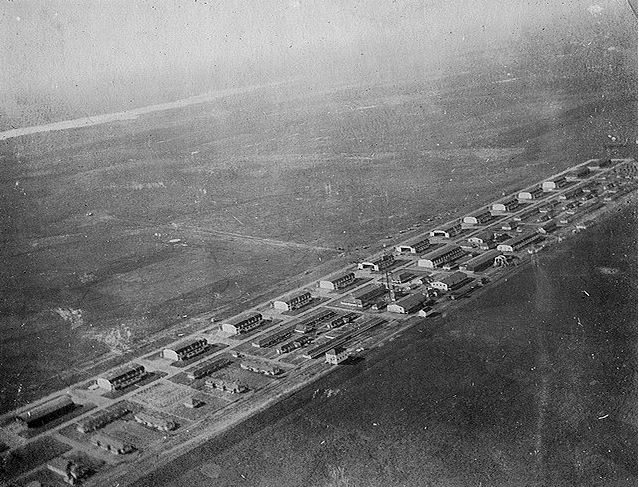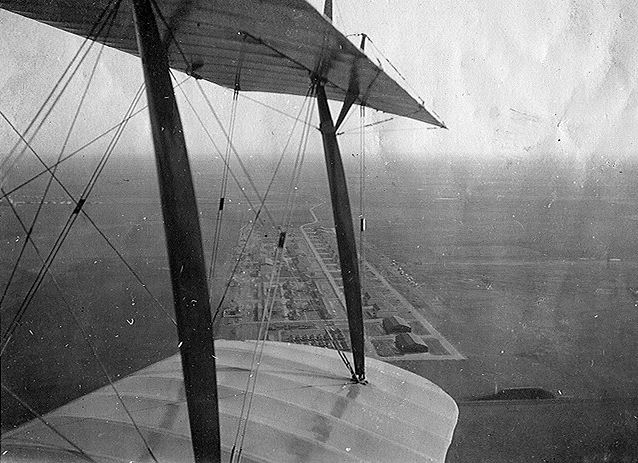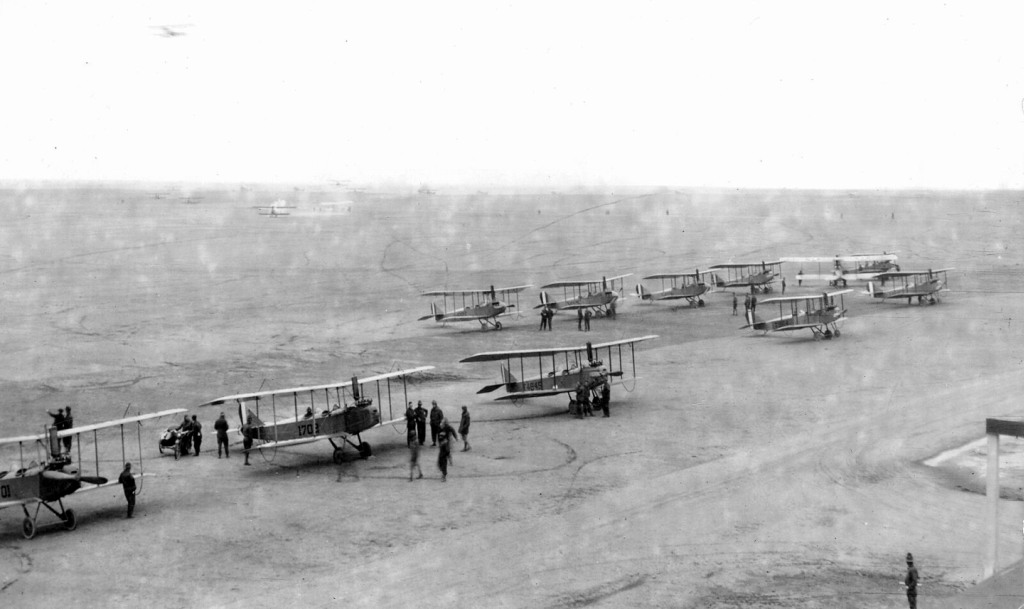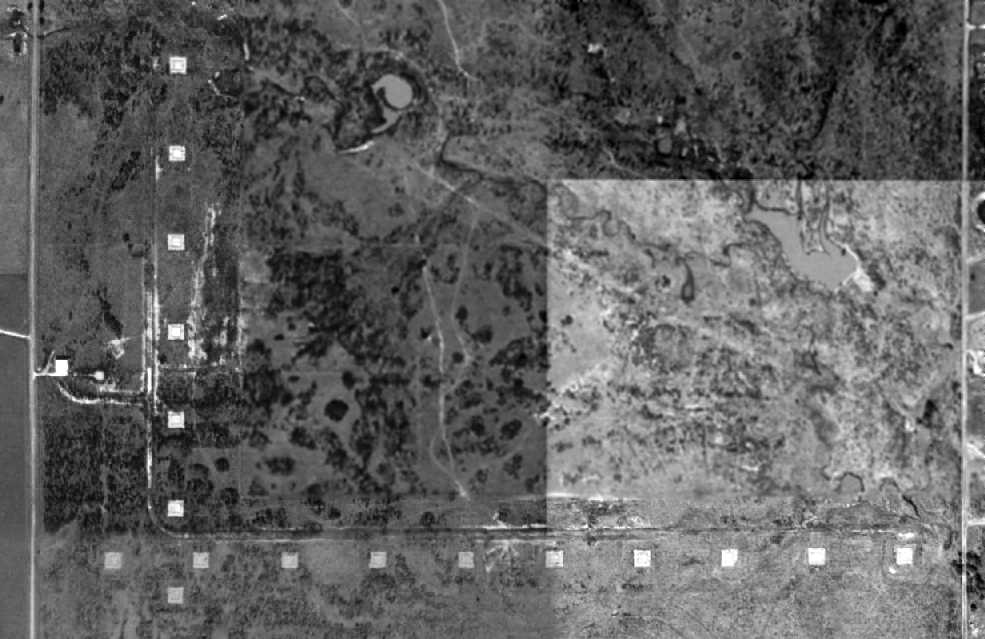
Abandoned & Little-Known Airfields:
Texas: Wichita Falls area
© 2002, © 2016 by Paul Freeman. Revised 1/24/16.
This site covers airfields in all 50 states: Click here for the site's main menu.
____________________________________________________
Please consider a financial contribution to support the continued growth & operation of this site.
Call Field (revised 1/24/16) - Sheppard AF Helicopter Annex #2 (revised 10/4/14)
____________________________________________________
33.87, -98.55 (Northwest of Fort Worth, TX)

A 1918 aerial view showing the long row of hangars at Call Field.
In April 1917 after the United States' entry into World War I, the Army announced its intention of establishing a series of camps to train prospective pilots.
Frank Kell of Wichita Falls organized an effort to attract the Army to the city.
In June 1917, the Department of War sent a cadre of officers to the Wichita Falls area to survey sites for an aviation school.
The group decided on a location about 5 miles southwest of Wichita Falls.
By 8/17/17, Kell & others successfully raised $35,000
and had a commitment from the Missouri, Kansas & Texas Railroad to extend tracks to the proposed site of the camp.
On August 27 construction began of the training field began.
It was one of 32 Air Service training camps established after the United States entry into World War I.
Call Field was named for 1st Lieutenant Loren Call who was killed in an airplane accident on 7/8/13.
Call Field had 46 buildings, which included 12 hangars that housed 4-8 planes each, a hospital, and 6 barracks that held 175 men each.
In May 1918 four additional hangars & a row of lofts to hold carrier pigeons were built.
It covered over 700 acres & could accommodate up to 1,000 personnel.
Dozens of wooden buildings served as headquarters, maintenance, and officers’ quarters.
Enlisted men had to bivouac in tents.
In November, when 85% of the work was completed, Maj. J. B. Brooks arrived to inspect the facilities.
On November 10 he was named commander.
On November 29 the 163rd Aero Squadron, equipped with 6 Curtiss JN-4 Jenny trainers arrived from Kelly Field, and the field had 600 pilots by late December.
Most of the JN-4 Jennys to be used for flight training, however, were shipped in wooden crates by railcar.
On 1/15/18 the army gave final approval of Call Field.
Call Field served as a base for flight training for the United States Army Air Service.
In 1918, flight training occurred in 2 phases: primary & advanced.
Primary training took 8 weeks & consisted of pilots learning basic flight skills under dual & solo instruction with a student capacity of 300.
After completion of their primary training, flight cadets were then transferred to another base for advanced training.

A 1918 aerial view showing the long row of hangars at Call Field taken from one of its Standard J-1 biplanes.

A circa 1918 U.S Army photo of a group of Standard J-1 biplanes at Call Field.
Training units assigned to Call Field were:
Post Headquarters, Call Field, November 1917-October 1919.
164th Aero Squadron, November 1917, re-designated as Squadron "A", July-November 1918.
192nd Aero Squadron, December 1917, re-designated as Squadron "B", July-November 1918.
198th Aero Squadron, December 1917, re-designated as Squadron "C", July-November 1918.
Squadron "D", transferred from Barron Field, TX, September-November 1918.
Squadron "E", transferred from Carruthers Field, TX, September-November 1918.
Flying School Detachment (Consolidation of Squadrons A-E), November 1918-November 1919.
Service units trained at Call Field were:
73rd Aero Squadron (II), March-July 1918; Deployed to American Expeditionary Forces, France.
74th Aero Squadron, March-August 1918; Transferred to Hazelhurst Field, NY.

A circa 1918 U.S Army photo of crew & a dog in front of a Standard J-1 biplane at Call Field.
During its operation 3,000 officers, cadets, and enlisted men were stationed at Call Field, and 500 officers received their wings there.
Two squadrons left the training facility for overseas duty.
Thirty-four men lost their lives during training exercises, the smallest number of fatalities of any U.S. military aviation training center up to that point.
With the sudden end of World War I in November 1918, the future operational status of Call Field was unknown.
Many local officials speculated that the U.S. government would keep the field open
because of the outstanding combat record established by Call-trained pilots in Europe.
Locals also pointed to the optimal weather conditions in the North TX area for flight training.
Cadets in flight training on 11/11/18 were allowed to complete their training, however no new cadets were assigned to the base.
Also the separate training squadrons were consolidated into a single Flying School detachment,
as many of the personnel assigned were being demobilized.
Finally, flight training activities ceased on 11/8/19.
In December 1919 Call Field was deactivated as an active duty airfield, however, and a small caretaker unit was assigned to the facility.
The War Department had ordered the small caretaker force to dismantle all remaining structures & to sell them as surplus.
In 1920 Ernest Hall, a former instructor at Call Field, operated a flying school at the facility.

A 1920 Agriculture Department Soil Map (courtesy of Randy Gilbert) depicted the row of hangars of Call Field, but labeled it as “Fair Grounds)”.
The Wichita Polo Club briefly used a portion of the land for its polo field.
In 1937 the Wichita Falls Junior Chamber of Commerce & American Legion
erected a small marker near the gates of the old field in memory of the 34 men who were killed during training.
For a number of years the site was the scene of memorial services by the Call Field Veterans Association.
The 1958 USGS topo map depicted a number of small buildings along Call Field Road, with a large open field to the north.

A 3/4/13 aerial view showed no trace remaining of Call Field.
The site of Call Field is located west of the intersection of McNiel Avenue 180 & Call Field Road, appropriately enough.
____________________________________________________
Sheppard AF Helicopter Training Annex #2, Iowa Park, TX
34, -98.63 (Northwest of Fort Worth, TX)

“H-2 AF Aux”, as depicted on the July 1968 Dallas Sectional Chart (courtesy of Chris Kennedy).
Photo of the airfield while in use has not been located.
This site might also have originally been home
to a First World War auxiliary field to Call Field (in Wichita Falls), called Iowa Park.
Nothing airfield-related was recognizable at this location on a 1953 aerial photo.
This small annex of nearby Sheppard Air Force Base was assigned in 1966,
and was apparently used to support Air Force helicopter training at that base.
The earliest depiction of the Sheppard Helicopter Annex #2 which has been located
was on the on the July 1968 Dallas Sectional Chart (courtesy of Chris Kennedy).
It depicted “H-2 AF Aux” as a heliport.
Larry DeVore (who was stationed at Sheppard AFB from 1968-71 as a HH-43B mechanic)
reported that "Annex #2 I think was used by the UH-1Fs & CH-3Cs."
Larry DeVore also recalled that Sheppard Helicopter Annex #1 was located in Grandfield, OK, and was used by HH-43Bs.
"The site (Annex #1) had a small metal building & a short paved runway,
as the HH-43B's could do rolling takeoffs & landings.
We had to either fly up or ride in the fuel truck as we had to refuel the helicopters after the training was over."
Sheppard AF Helicopter Training Annex #2 was disposed of in 1972.
The property was labeled "Sheppard Air Force Base Small Arm Range Annex" on the 1972 USGS topo map.
"H-2 AF Aux" was still depicted as an active heliport on the 1978 DFW Sectional Chart (courtesy of Ray Brindle).
The Sheppard Annex #2 was not depicted at all on the 1979 or 1983 USGS topo maps.

A 1/29/95 USGS aerial photo showed the airfield facilities at Sheppard AFB Annex #2
to consist of 2 rows of a total of 17 helicopter landing pads, each a 90' square of concrete.


A 12/26/11 aerial photo showed the helicopter facilities at Sheppard AFB Annex #2 to remain unchanged.

A circa 2011 aerial view looking west at the 3 of the helicopter landing pads & the support building on the west side of Sheppard AFB Annex #2.
Sheppard AFB Annex #2 is located on the east side of Peterson Road, 3 miles northeast of Iowa Park, TX.
____________________________________________________
Since this site was first put on the web in 1999, its popularity has grown tremendously.
That has caused it to often exceed bandwidth limitations
set by the company which I pay to host it on the web.
If the total quantity of material on this site is to continue to grow,
it will require ever-increasing funding to pay its expenses.
Therefore, I request financial contributions from site visitors,
to help defray the increasing costs of the site
and ensure that it continues to be available & to grow.
What would you pay for a good aviation magazine, or a good aviation book?
Please consider a donation of an equivalent amount, at the least.
This site is not supported by commercial advertising –
it is purely supported by donations.
If you enjoy the site, and would like to make a financial contribution,
you
may use a credit card via
![]() ,
using one of 2 methods:
,
using one of 2 methods:
To make a one-time donation of an amount of your choice:
Or you can sign up for a $10 monthly subscription to help support the site on an ongoing basis:
Or if you prefer to contact me directly concerning a contribution (for a mailing address to send a check),
please contact me at: paulandterryfreeman@gmail.com
If you enjoy this web site, please support it with a financial contribution.
please contact me at: paulandterryfreeman@gmail.com
If you enjoy this web site, please support it with a financial contribution.
____________________________________________________
This site covers airfields in all 50 states.